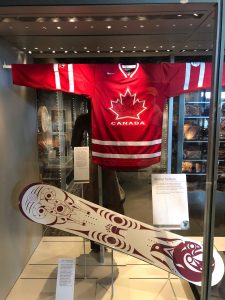
The ‘Blended Traditions’ exhibit displays contemporary Coast Salish art pieces which represent the blending of cultural symbols, brought to life on a hockey jersey and snowboard. The hockey jersey was worn by the 2010 Canadian Olympic Hockey team, and designed by Debra Sparrow, who is a Coast Salish artist. Within the jersey’s maple leaf logo are cultural symbols that not only represent Coast Salish culture, but all cultures of Canada. Some iconography included in this logo consist of the fleur-de-lis, representing French-Canadians of Canada, and various animals commonly associated with Canada including the orca, beaver, and moose. Also included front and centre on the crest is the Thunderbird, which is a well known symbol of indigenous art and culture. Additionally, the design’s overall shape and symmetrical nature may remind the viewer of a totem pole. When these cultural symbols are combined in this logo, and placed within arguably the most recognizable Canadian symbol, the maple leaf, the result is a perfect depiction of ‘Blended Traditions’. The snowboard is named ‘The Challenger’, and was designed for the First Nations Snowboard Team by Rick Harry. Because this snowboard is meant for this first nations team, it only includes indigenous symbols designs. Rick Harry states that ‘The Challenger’ includes Coast Salish eyes and the Sxwayxway mask, while the board’s colour scheme signifies protection.
Both pieces represent the blending of cultures and traditions, leading the viewer to believe that these pieces each reflect a similar view on indigenous identity. Both the hockey jersey and ‘The Challenger’ include indigenous art on non-traditional materials, presenting the idea that indigenous traditions can be blended with traditions shared and celebrated by all cultures in Canada such as hockey and snowboarding. Despite this similarity, it is safe to say that the logo on the jersey is a bolder take on blending traditions, as unlike the ‘The Challenger’ which only contains indigenous art as it is meant to represent the First Nations team, a larger variety of Canadian iconography is included within the jersey’s maple leaf logo as it is meant to represent all of Canada. Even when this difference is noted, the decision by the curatorial staff to place these works in the same display makes perfect sense, as they both are clear representations of ‘Blended Traditions’.
To Canadians, the iconography included on these pieces are quite recognizable. These works would presume that the viewer, specifically the Canadian viewer is aware of background information surrounding these works. The average Canadian would be able to identify that this is a blending of cultures and traditions. It would be less expected for a non-Canadian to recognize the iconography within these works. I believe that the average Canadian has this information as today, Canadians usually hold a higher degree of knowledge when it comes to these cultural symbols as schools are beginning to explore these cultural topics at an increasing rate.
